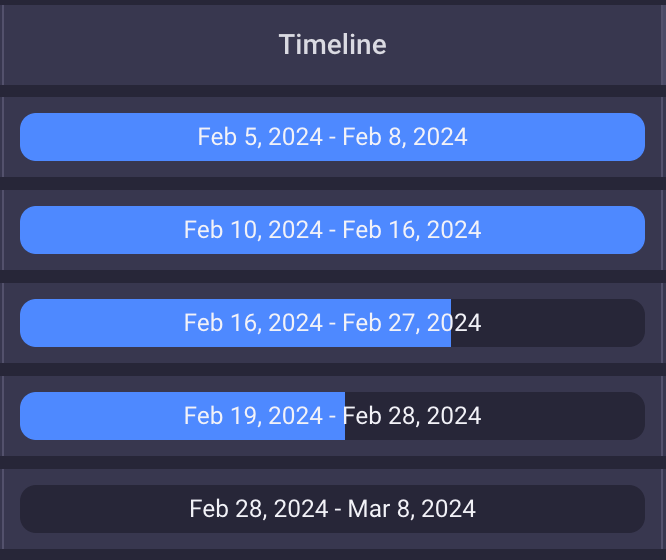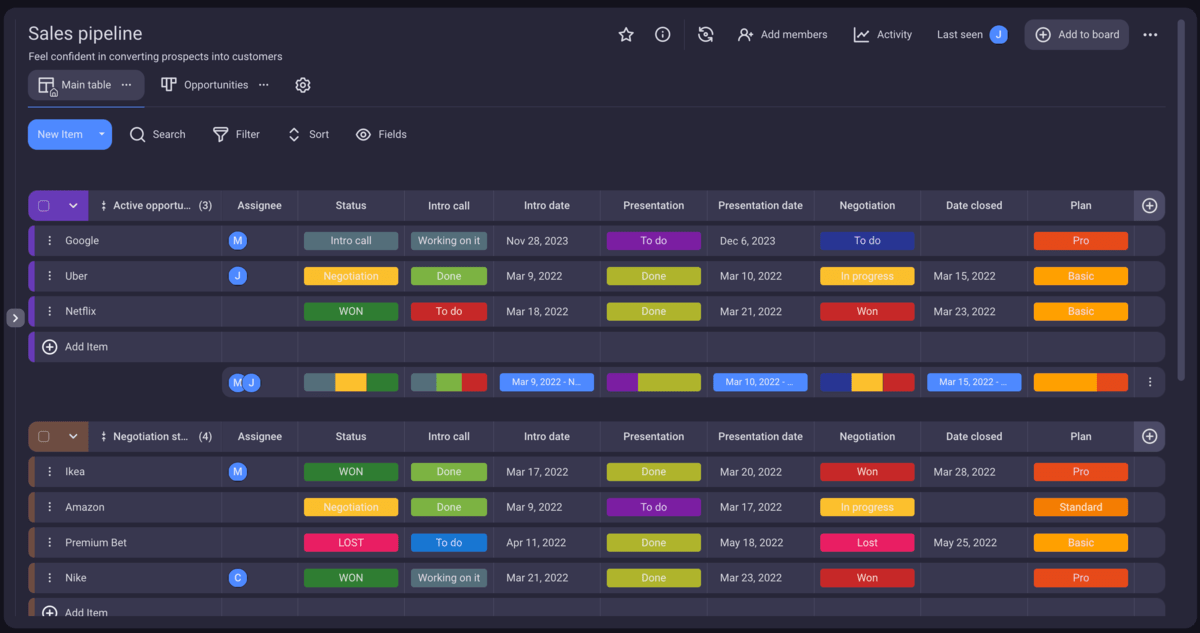Did you know that nowadays more and more companies are looking to hire an experienced sales project manager for their projects?
And, if you’re wondering what a sales project manager’s actual job is, and why it’s so important — you’re in the right place.
In this blog post, you’re going to learn everything you need to know about sales project management, including:
- What sales project management means,
- What a sales project is,
- How sales is related to project management,
- What sales project manager skills and responsibilities are, and
- What techniques are important in sales project management.
So, keep reading!

In this article:
What is sales project management?
Sales project management can be defined as the application of project management skills, tools, and techniques on sales to improve the company’s sales process and achieve desired outcomes.
Sales management and project management (PM) have a lot in common, including similarities between:
- Sales cycle phases and project cycle phases,
- Sales management skills and project management skills, and
- Sales management principles and project management principles.
Due to these overlaps, many organizations strongly encourage their sales managers to learn about basic project management concepts and possibly acquire one of the most respected PM certificates.
Sales project example
If you understand the theory but are still not sure what a sales project looks like in practice — we’ve prepared an example.
Let’s imagine that you’re a salesperson who has recently become a sales project manager.
You’ve been asked to increase the company’s overall sales by 10%.
Next, you’ve added the beginning and end date to that request, e.g. the total time amounting to a year starting from that moment.
After defining dates, what you’ll need to do is:
- Set a concrete goal or target,
- Create a project schedule,
- Create a project budget,
- Create project milestones,
- Assign project roles, and
- Assign project tasks.
After you’ve outlined your strategic plan, you can start putting the plan into action.
And, congratulations!
You’ve got yourself a new sales project.
What does a sales project manager do?
Regardless of the industry, a sales project manager’s job has a similar description.
Generally, a sales project manager’s responsibilities are to:
- Upgrade the sales processes and identify areas for improvement,
- Track key project performance indicators (KPIs),
- Identify critical success factors leading to closed deals, and identify rejection factors,
- Monitor market trends and changes in customer demands,
- Develop strategies to meet customers’ needs;
- Help generate strategic marketing plans and campaigns,
- Initiate, nurture, and grow customer relationships,
- Direct, coordinate, and monitor the sales team,
- Collaborate with other project teams to identify potential roadblocks,
- Ensure project delivery on time and within budget, and
- Use various sales task management tools.
All these project activities require the sales project manager to be an organized individual and a problem solver with excellent communication skills.
In the next chapter, we’ll cover the most important sales project manager skills in more detail.
💡 Plaky Pro Tip
To learn more about project manager roles and responsibilities, read this guide:
5 Essential sales project manager skills
As we’ve already mentioned, it’s preferable that sales managers possess both project management skills and people management skills.
Now, let’s cover the 5 specific skills and abilities a good sales project manager should have.
Skill #1: Organization
Good organizational skills imply being able to break down complex tasks into manageable chunks.
If a manager is unable to organize the project workflow properly, potential mismanagement issues can arise that could negatively impact:
- Team performance,
- Task allocation,
- Team roles and responsibilities, and
- Customer satisfaction.
Skill #2: Leadership
Sales project managers should coach and mentor their team members — it will encourage them to work hard and reach the desired goals.
A good leader should create a positive atmosphere and motivate their teams to increase performance and achieve success by:
- Giving constructive feedback,
- Practicing strategic thinking, and
- Being a role model to their team members.
Skill #3: Flexibility
Good sales project managers should be able to balance project demands and the team’s abilities and needs.
Also, they should be able to quickly respond to changes and manage project risks as their flexibility might determine sales outcomes.
Skill #4: Transparency
Sales project managers should demonstrate honesty and transparency in communication with their team.
By being open with what they want to achieve, managers will make their team feel more responsible to work toward the goal.
Skill #5: Time management
Sales project managers should know how to organize their time right and which tools to use to assist them.
After all, they are responsible for their own schedule and the entire team’s schedule.
As wasting time usually costs money, good sales project managers should avoid:
- Spending unnecessary time and resources on improbable or unworthy projects, and
- Avoid missing project deadlines on important deals.
Plaky project management tool offers transparent time management features, such as a built-in calendar for tracking due dates and project deadlines.

6 Important sales project management techniques
In the long run, applying project management knowledge to your sales strategies may result in:
- Increased customer satisfaction,
- Increased customer base,
- More closed sales, and
- Increased revenues.
Yet, to achieve sales success, you’ll first need to go over the specific techniques to get you there.
Let’s cover the 6 best sales project management techniques.
Technique #1: Defining project goals
One of the initial steps in creating a sales strategy is to define your goals.
However, to do it appropriately, you should follow the SMART goals format, where objectives need to be:
- Specific,
- Measurable,
- Achievable,
- Realistic, and
- Time-based.
So, for example, the goal to “increase market share” isn’t specific enough, while “increase market share by 10% by 2024” is.
As long as your goals are SMART, sales managers and the sales team will remain optimistic and motivated to achieve them.
💡PLAKY PRO TIP
Having a sales plan also helps. And, the best thing is, you don’t need to start from scratch! We have 7 sales plan templates for you to try:
Technique #2: Planning milestones
Defining milestones is crucial in making a complex long-term goal more achievable.
To do that, you should divide the process into smaller steps, that is, short-term objectives called project milestones.
Marking each milestone will help follow the company’s gradual progress toward the final objective.
For example, your long-term objective can be to become the No.1 mobile network operator company within the period of 2 years.
One of your milestones could be taking the fourth place on the market, and another, taking the third.
You can continue to follow your progress by celebrating key milestones until you reach the final goal.
Technique #3: Defining risks
By managing risks in sales project management, you can stay prepared for all possible outcomes of your project.
There’s a smaller chance of being caught off guard if something doesn’t go according to the initial project plan when you’ve defined project risks on time.
Though a sales project manager should try to keep the project going smoothly, they should also have a plan B if the project goes off track.
One of the sales project management skills includes preventing common sales obstacles, such as:
- Not accounting for all costs and contingencies,
- A lack of customer insights for sales reps to work with,
- Missed upselling opportunities, or
- Inaccurate KPIs.
Technique #4: Identify lessons learned
After the sales project closure stage, sales project managers should identify the so-called lessons learned and preferably hold a lessons learned meeting.
In the meeting, the sales team should address all the things that went right and all that went wrong during the project.
The purpose of lessons learned is to draw conclusions for future projects and better prepare for the next time.
Also, it is preferable if lessons learned are clearly documented and easily accessible for future reference.
💡Plaky Pro Tip
If you want to learn more about lessons learned, read this blog post:
Technique #5: Use CRM software
As explained in Pearson’s Sales Management, customer relationship management (CRM) facilitates identifying and grouping customers, thus helping an organization develop an appropriate strategy to:
- Acquire customers,
- Retain customers, and
- Grow its business.
CRM software is handy as it allows real-time access to information where you are immediately notified about changes.
Another important CRM characteristic is that it makes it easier to manage opportunities, which implies identifying prospective customers or sales opportunities.
Here’s what tracking customer data may look like in a project management tool Plaky:

As you can see in the above example, sales deals are together managed as an individual project.
The project management app is used for keeping track of various sales deal information, including:
- Deal owner,
- Deal priority,
- Deal status,
- Deal probability, or
- Deal value.
Robust sales management tools such as Plaky help streamline your sales process and customize each sales project to suit your company’s specific needs.
💡 Plaky Pro Tip
If you’re looking for a robust CRM solution for your small business, we got you covered — check out our top 10 list and find the software that works best for you:
Technique #6: Visualizing the sales pipeline
Having a visual representation of your sales pipeline allows keeping track of the stage your customers are currently in.
Though each company can customize its sales pipeline, here’s our example of what it can look like in Plaky:

As you can see in the example, the sales pipeline provides a clear overview of the specific phase of the pipeline clients are in, e.g.:
- Awaiting clients,
- Onboarding clients, or
- Paying clients.
Having gathered as much information on the clients in each phase, sales project managers can use this data to draw conclusions about the sales management process.
After that, they can implement any changes if necessary.
A transparent pipeline can show the bigger picture of your sales process and modify the sales strategy to improve performance.
Conclusion: A sales project manager on the team can help improve the sales process
Planning a company’s sales process can be challenging for sales managers, as it often implies juggling several projects and a bit too many responsibilities.
To make their job easier, sales managers should educate themselves on various PM methodologies, tools, and techniques.
With many common characteristics, sales and project management combined, are likely to increase team efficiency and bring the desired results to a company.
✉️ Can you think of any other important insight about sales project management? If yes, feel free to contact us at blogfeedback@plaky.com, and we may include your ideas in this or any other future blog posts. Also, if you liked this blog post and found it useful, share it with someone you think would also benefit from it.

